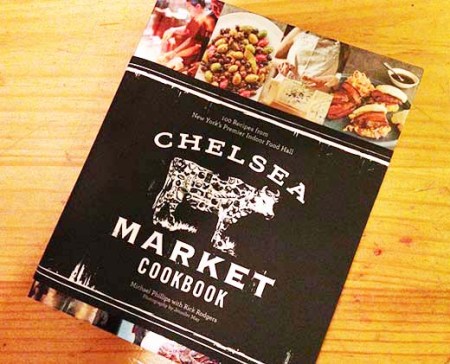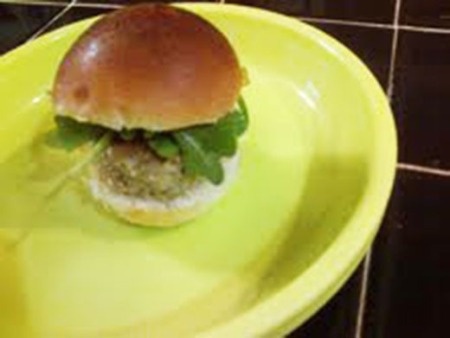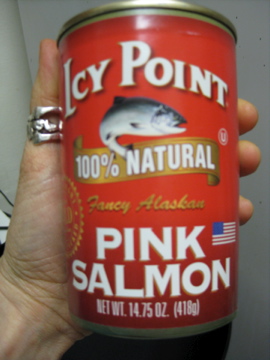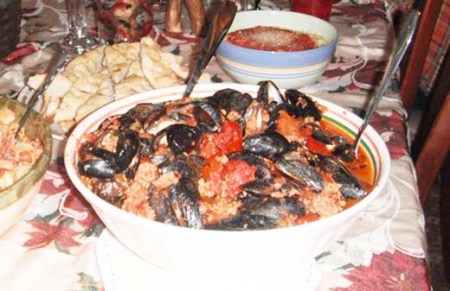A while back MG and I contributed some recipes to a secret project. Now the official Chelsea Market Cookbook is here! Let the world be exposed to Metalbelly‘s Texas Chili and my own golden garlic butter, that mysteriously tastes just like movie popcorn, as well as great stuff from people way more famous than us… lots of them! Check it out at Amazon.
One of my recipes, originally titled ‘Market Fish Stew’, was retitled Provençal Fish Stew and likened to a bouillabaisse in its description. While the use of leeks, fennel and pastis are typical of Provence, I have to admit my dish is way too simple (and adaptable) to hold court in the tradition of bouillabaisse. If the recipe I developed for the Chelsea Market Cookbook is a speedboat, the bouillabaisse I ate many years ago, at a tiny port restaurant in Marseille, was a French naval ship.
That first time, I didn’t really know what I was in for while hunting for the historic soup, but my goal was to find the perfect place to eat it. It should be noted, this was before personal opinions could be publicly accessed with ease. I couldn’t look at scores of reviews, there was no googling to be done. These were my early days of culinary exploration and because there were fewer resources, I was honing the skill of spotting a real deal restaurant by wits alone. With each new travel, in seas of tourist traps and among hordes of menus and foreign words, finding the local gem just by scanning the immediate details became my superpower.
The day I went shopping for bouillabaisse, I was on a solo mission with no one to translate or steer. As I wound through the streets of the port I scanned for a place with just the right light, a healthy level of sound, happy relaxed guests and staff, good smells. My ideal was smallish in size and maybe a bit off the path. Scan the menu, is it traditional and also unique? Is there variety, is there a clear specialty? This is the first glance.
I found my spot and ordered a bouillabaisse. Soon after, the waiter presented me with a plate of raw Mediterranean fish and various sea animals. However confused, I signed off with a nod. He disappeared leaving me to devour a whole basket of bread and rouille, a garlic and saffron ailoi, named for its color (rust). Rouille is a mandatory part of a bouillabaisse, meant to be sunk in the bottom of the soup, making the broth thicker and richer –not eaten as an appetizer. The waiter came back with a huge bowl brimming with the seafood in an incredible broth, thick with fishy shrapnel and a little gritty with seasonings. As I worked my way through that bowl of perfectly cooked fish, my guy refilled broth from a tureen and bread/rouille as needed. It was impossible to stop eating this bottomless bowl, and I probably took down enough for four people.
Sorry to report that I don’t know the restaurant name or the street it was on. I didn’t write notes on food then or take pictures of my meals with the enormous Nikkormat I was probably carrying. Since this momentous meal, I have researched and discussed many more details of regional French cooking, learning that there is much debate about what an authentic bouillabaisse really is; seasoning, type of fish, order of plating, etc. In my food-obsessed travels I realize that eating any dish in the place of its origin is such a unique sensory experience that it is hard to describe the final criteria when looking for the best local spot. One might say that you have to give yourself over to the place you are visiting, and its customs, in order to be admitted passage to an authentic experience. If you search for a restaurant with ketchup bottles on the table wherever you go, it is sure you will be denied this.
I walked Marseille top to bottom, letting it take me where it would. On a desolate road that ran alongside the sea, there were signs indicating boats in transit to/from Corsica, Italy and Algeria. I remember reading the exotic port names and feeling small and far away, isolated from the rest of the world (remember, no cellphones). I accepted that no one on the continent knew where I was at that moment and I could be anywhere according to the rest of the world. I continued into the ‘the pannier’ or old town which was a tight maze of narrow corridors. It must have been during a particularly quiet siesta because what was described to me as the must-see, crazy, condensed part of town was silent. The strange, lonely feeling deepened but didn’t last long. The noise level rose as the streets pointed back toward port and I turned a corner just in time to see an outdoor beer garden full of people (travelers) just like me. I hung with them for a bit before the desire to continue my loner journey resumed.
I bought some cheap cigarettes in an alleyway. I happened upon a gallery opening in a cavernous garage-like space with minimalist paintings and loads of wine. Way earlier that day I trekked around the moon rocks of the Calanques peering down at the very place the delicious bouillabaisse fish come from. Traveling with my stunning vintage Laguiole (like a good Frenchman), I sliced saucisson and broke bread under the immense statues of the Palais Longchamp before wandering the fine arts museum inside. At night I sketched the illuminated windows of St. Vincent de Paul and pretended I spoke only Bulgarian to maintain my solitude when approached by curious passers by.
I fell in love with Marseille and its briny breeze. Was intrigued by the local accent and its choppy Italian inflection, the cultural mash-up, the crossroads and that overall, “hey! we’ve got a port so we can go anywhere, but we stay right here” kind of feeling. And after taking all that in, I’m pretty sure I had a spot on bouillabaisse that day.










